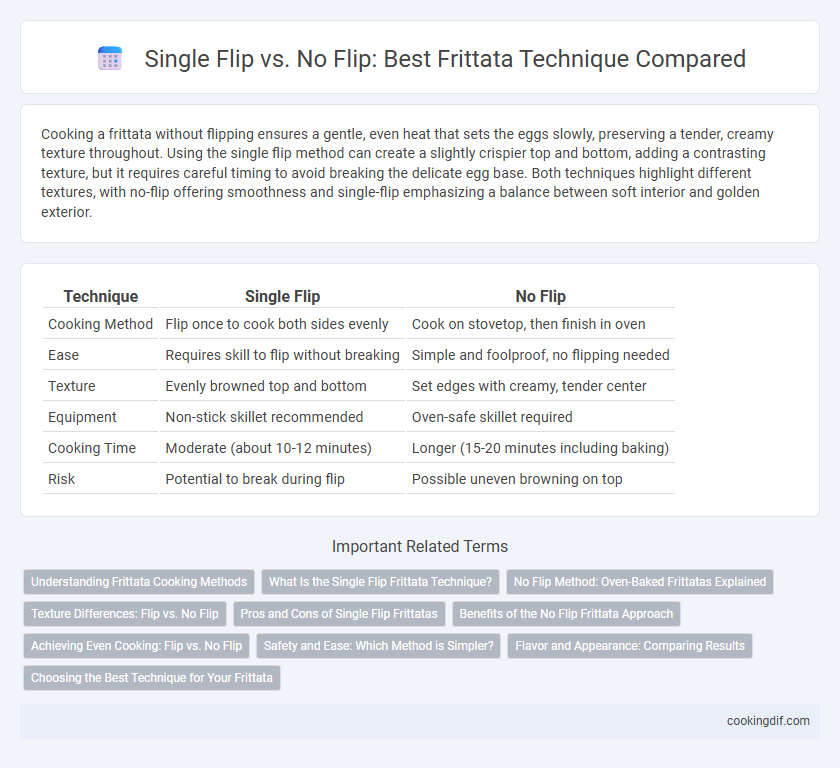Cooking a frittata without flipping ensures a gentle, even heat that sets the eggs slowly, preserving a tender, creamy texture throughout. Using the single flip method can create a slightly crispier top and bottom, adding a contrasting texture, but it requires careful timing to avoid breaking the delicate egg base. Both techniques highlight different textures, with no-flip offering smoothness and single-flip emphasizing a balance between soft interior and golden exterior.
Table of Comparison
| Technique | Single Flip | No Flip |
|---|---|---|
| Cooking Method | Flip once to cook both sides evenly | Cook on stovetop, then finish in oven |
| Ease | Requires skill to flip without breaking | Simple and foolproof, no flipping needed |
| Texture | Evenly browned top and bottom | Set edges with creamy, tender center |
| Equipment | Non-stick skillet recommended | Oven-safe skillet required |
| Cooking Time | Moderate (about 10-12 minutes) | Longer (15-20 minutes including baking) |
| Risk | Potential to break during flip | Possible uneven browning on top |
Understanding Frittata Cooking Methods
Single flip technique in frittata cooking involves gently turning the partially cooked egg mixture to ensure even browning and a well-set texture, which can enhance the crust formation and add a smoky flavor. No flip method relies on baking or slow cooking the frittata entirely on one side, usually finished in the oven, preserving a tender, custardy interior without disrupting its shape. Understanding these methods allows cooks to choose between a browned, steak-like surface or a smooth, consistent egg dish depending on texture preference and equipment availability.
What Is the Single Flip Frittata Technique?
The single flip frittata technique involves cooking the egg mixture mostly on the stovetop before flipping the entire frittata once to finish cooking the other side. This method helps achieve an even golden crust while maintaining a tender, custard-like interior. Compared to the no-flip technique, the single flip offers a balanced texture and visually appealing presentation.
No Flip Method: Oven-Baked Frittatas Explained
The no flip method for making frittatas involves baking the mixture entirely in the oven, resulting in even cooking and a uniform, fluffy texture without the risk of breaking the eggs. This oven-baked technique eliminates the need to skillfully flip the frittata, making it especially beginner-friendly and ideal for thicker, vegetable-packed versions. Using a preheated oven set around 350degF (175degC) ensures a perfectly set frittata with a golden top and tender interior.
Texture Differences: Flip vs. No Flip
Flipping a frittata results in a uniformly cooked texture with a slightly crisp exterior and a tender, fluffy interior due to direct heat exposure on both sides. Cooking without flipping preserves a creamier, custard-like texture on top, as the heat gently sets the eggs through baking or stovetop steaming. The choice between flip and no flip methods significantly influences the final mouthfeel, with flipping offering contrast in firmness and no flipping maintaining a delicate softness throughout.
Pros and Cons of Single Flip Frittatas
Single flip frittatas offer a golden-brown, evenly cooked top surface, providing a visually appealing and slightly crispy texture. The technique requires skill to avoid cracks or breaking, posing a challenge for novices. Compared to no-flip methods, single flipping ensures thorough cooking but may increase preparation time and risk of unevenness if not done carefully.
Benefits of the No Flip Frittata Approach
The no flip frittata technique retains a tender, custard-like texture throughout by allowing gentle, even cooking in the oven, reducing the risk of breaking or uneven cooking commonly seen with flipping. This approach enhances flavor absorption from ingredients as the frittata remains undisturbed, preserving a uniform consistency and preventing potential mess. Baking the frittata without flipping also simplifies the process, making it beginner-friendly while ensuring a visually appealing and evenly set dish.
Achieving Even Cooking: Flip vs. No Flip
Achieving even cooking in frittatas depends on the technique, where single flip provides a balanced approach by allowing both sides to cook directly on the heat source, resulting in a well-set, slightly crispy bottom and a tender top. The no-flip method leverages gentle oven baking or stovetop simmering with a lid, which evenly transmits heat through steam, producing a uniformly cooked, fluffy texture without browning. Understanding heat distribution and moisture retention is essential when choosing between flip and no-flip techniques to achieve the desired frittata consistency and surface finish.
Safety and Ease: Which Method is Simpler?
The no-flip method for cooking a frittata is safer and simpler than the single-flip technique, eliminating the risk of spills or burns associated with flipping the hot pan. This approach involves slow cooking on low heat until the eggs set, requiring minimal skill and reducing the chance of accidents. Home cooks often prefer no-flip frittatas for ease, while single-flip variants demand careful handling and experience to achieve an even, golden crust.
Flavor and Appearance: Comparing Results
Single flip technique in frittata cooking enhances flavor through even browning and caramelization, resulting in a richer taste profile and a golden crust. No flip method maintains a uniform, softer texture with a paler appearance, emphasizing a creamier interior but less pronounced surface flavor. Comparing the two, single flip offers a visually appealing frittata with intensified flavors, while no flip delivers a smoother, less crispy presentation.
Choosing the Best Technique for Your Frittata
Choosing between single flip and no flip techniques for your frittata depends on texture preference and cooking equipment. Single flip offers a lightly crisp top and even cooking by quickly inverting the frittata, ideal for those who prefer a browned finish. No flip method, often finished under a broiler, is simpler and retains a moist, custard-like interior, perfect for delicate fillings and minimal handling.
Single flip vs No flip for frittata technique Infographic

 cookingdif.com
cookingdif.com